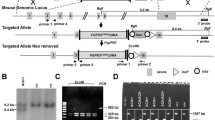Abstract
Achondroplasia, the most common form of chondrodysplasia, has been associated with mutations in the gene of the fibroblast growth factor receptor-3 (FGFR-3) on chromosome 4p. All 39 achondroplasia alleles studied so far carried point mutations which caused the same amino acid exchange, a substitution of glycine by arginine at position 380 (G380R) in the transmembrane domain of the receptor. We report on a newborn with achondroplasia who does not carry a G380R mutation but has a mutation causing substitution of a nearby glycine with a cysteine (G375C). This observation indicates allelic heterogeneity and confirms the role of mutations in the transmembrane domain of FGFR-3 in the pathogenesis of achondroplasia.
Similar content being viewed by others
Abbreviations
- FGFR-3 :
-
fibroblast growth factor receptor-3
- G-to-A :
-
guanosine-to-adenosine transition
- G-to-C :
-
guanosine-to-cytidine transversion
- G-to-T :
-
guanosine-to-thymidine transversion
- G375C :
-
glycine-to-cysteine substitution at position 375
- G380R :
-
glycine-to-arginine substitution at position 380
- PCR :
-
polymerase chain reaction
- SSCP :
-
single-strand conformation polymorphism
References
Horton WA, Hecht JT (1993) The chondrodysplasias. In: Royce PM, Steinmann B (eds) Connective tissue and its heritable disorders—molecular, genetics, and medical aspects. Wiley-Liss, New York, pp 641–675
Keegan K, Johnson DE, Williams LT, Hayman MJ, (1991) Isolation of an additional member of the fibroblast growth receptor family, FGFR-3. Proc Natl Acad Sci USA 88:1095–1099
Langer LO, Baumann PA, Gorlin RJ (1967) Achondroplasia. Am J Roentgenol 100:12–26
Le Merrer M, Rousseau F, Legeal-Mallet L, Landais JC, Pelet A, Bonaventure J, Sanak M, Weissenbach J, Stoll C, Munnich A, Maroteaux P (1994) A gene for achondroplasia-hypochondroplasia maps to chromosome 4p. Nature Genet 6:318–321
Ornitz DM, Leder P (1992) Ligand specificity and heparin dependence of fibroblast growth factor receptors 1 and 3. J Biol Chem 267:16305–16311
Pasquale EB (1990) A distinctive family of embryonic protein-tyrosine kinase receptors. Proc. Natl Acad Sci USA 87:5812–5816
Rimoin DL, Lachman RS (1993) Genetic disorders of the osseous skeleton. In: Beighton P (ed) Heritable disorders of connective tissue, 5th ed. Mosby-Year Book, St. Louis, pp 557–689
Robinow M, Chumlea WC (1982) Standards for limb bone length ratios in children. Radiology 143:433–436
Rousseau F, Bonaventure J, Legeal-Mallet L, Pelet A, Rozet JM, Maroteaux P, Lemerrer M, Munnich A (1994) Mutations in the gene encoding fibroblast growth factor receptor-3 in achondroplasia. Nature 371:252–254
Shiang R, Thompson LM, Zhu YZ, Church DM, Fielder TJ, Bocian M, Winokur ST, Wasmuth JJ (1994) Mutations in the transmembrane domain of FGFR-3 cause the most common genetic form of dwarfism, achondroplasia. Cell 78:335–342
Superti-Furga A, Steinmann B, Duc G, Gitzelmann R (1991) Maternal phenylketonuria syndrome in cousins caused by mild, unrecognized phenylketonuria in their mothers homozygous for the phenylalanine hydroxylase Arg-261-Gln mutation. Eur J Pediatr 150:493–497
Thompson LM, Plummer S, Schalling M, Altherr MR, Gusella JF, Housman DE, Wasmuth JJ (1991) A gene encoding a fibroblast growth factor receptor isolated from the Huntington disease gene region of human chromosome 4. Genomics 11:1133–1142
Velinov M, Slaugenhaupt SA, Stoilov I, Scott CI, Gusella JF, Tsipouras P (1994) The gene for achondroplasia maps to the telomeric region of chromosome 4p. Nature Genet 6:314–317
Author information
Authors and Affiliations
Rights and permissions
About this article
Cite this article
Superti-Furga, A., Steinmann, B., Gitzelmann, R. et al. A glycine 375-to-cysteine substitution in the transmembrane domain of the fibroblast growth factor receptor-3 in a newborn with achondroplasia. Eur J Pediatr 154, 215–219 (1995). https://doi.org/10.1007/BF01954274
Received:
Accepted:
Issue Date:
DOI: https://doi.org/10.1007/BF01954274




